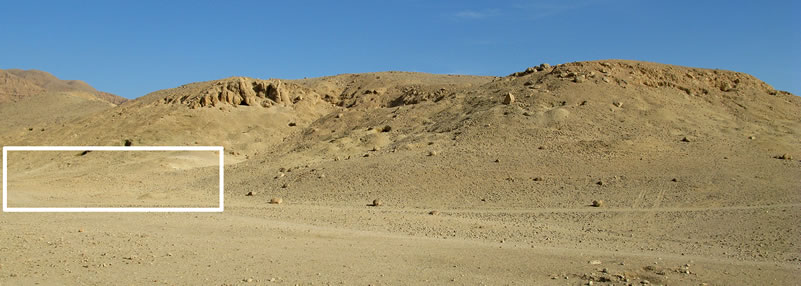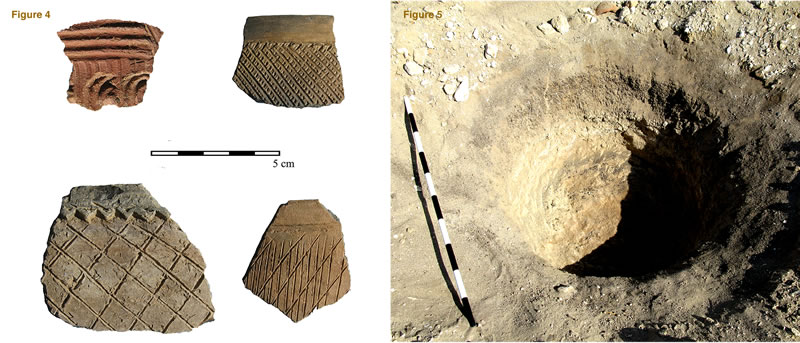A Pan Grave Cemetery: Area H3
On a small north-south spur jutting out from Area H2 our survey revealed a series of Pan Grave burials (Figure 1).1 The graves were heavily disturbed, but collection of surface remains was productive, providing us with a small, yet varied, corpus of decorated and polished sherds typical of the Pan Grave culture, associated with at least two sherds from Upper Egyptian ceramic tradition of the Second Intermediate Period: a storage jar rim to neck2 (Figure 2a; Nile B2) and Marl A3 cup with slightly outflaring rim3 (Figure 2b).

The Pan Grave ceramic material includes five partial vessel profiles: Figure 3a-c are black-topped red-ware;4 Figure 3d has a yellowish-brown polished exterior;5 Figure 3e has a red exterior with incised decoration.6 The diversity of surface treatment and decoration among the smaller Pan Grave sherds is striking (Figure 4).7 One of the more unusual decorative schemes are the sherds with deeply incised curved lines; parallels do not appear in the Pan Grave cemeteries from Nubia, but similar decoration is found in the cemeteries of Mostagedda8 and Balabish.9

Two of the circular burials were cleared of sand debris, revealing the characteristic round, shallow Pan-Grave tombs dug into the wadi deposit (Figure 4a, M08-09/H3.2);10 the interior of M08-09/H3.1, which appears to be the tomb of a child, was coated with a mud plaster.11 In addition to the ceramic remains, both Pan Grave tombs contained fragments of worked leather, a common object type in Nubian burials.

The newly discovered Pan Grave cemetery at Mo‘alla augments the known Pan Grave material from ed-Deir12 (12 km to the south) and Esna;13 since only a few sherds from each of those sites is published, the recording and clearance of the Pan Grave cemetery at Mo‘alla may provide new data regarding regional variations in this wide-spread Nubian culture.14 Although the clearance of two burials and collection of surface remains around the Pan Grave cemetery does not allow any definite conclusions, additional clearance in the Pan Grave cemetery may shed further light on the history of this region during the Theban-Hyksos conflicts. Future excavations will most likely confirm the recent re-evaluation of the Hyksos blocks from Gebelein, which were probably spoils of war after the Theban victory in the north, rather than evidence for Fifteenth Dynasty construction projects and/or military zones in the area of Gebelein.15 Considering the false importance that has been attributed to these blocks, the Mo‘alla Survey Project’s results will hopefully contribute to a more accurate understanding of the geo-political situation of the Third Nome during the Second Intermediate Period.
Notes
- 1. Despite the widespread nature of Pan Grave material in Upper Egypt, a more general study of this Nubian group is lacking; overall discussions of their material culture and geographical range include M. Bietak, “The C-Group and Pan-Grave Culture,” in T. Hägg, ed., Nubian Culture, Past and Present (Sweden, 1986), pp. 113-128;idem., Studien zur Chronologie der nubischen C-Gruppe (Vienna, 1968), pp. 117-123; K. Sadr, “The Territorial Expanse of the Pan-Grave Culture,” Archéologie du Nil Moyen 2 (1987): 265-291; G. Meurer, Nubier in Ägypten bis zum Beginn des Neuen Reiches. Zur Bedeutung der Stele Berlin 14753 (Berlin, 1996), pp. 70-72; Thomas Schneider, Ausländer in Ägypten während des Mittleren Reiches und der Hyksoszeit, Vol. 2, Die ausländische Bevölkerung (Wiesbaden, 2003), pp. 92-93; T. Säve-Söderbergh, ed., Middle Nubian Sites (SJE 4:1; Uddevalla, 1989), vol. 1, pp. 15-23; J. Bourriau, “Nubians in Egypt During the Second Intermediate Period: An Interpretation Based on the Egyptian Ceramic Evidence,” in Do. Arnold, ed., Studien zur altägyptischen Keramik (Mainz am Rhein, 1981), pp. 25-41.
- 2. Parallels to this storage jar type include von Pilgrim, Elephantine XVIII, pp. 326-327, fig. 144a (Bauschicht 11; 17th Dynasty); G. Brunton, Mostagedda and the Tasian Culture (London, 1937), pl. LXXV, No. 3 (from a Pan Grave cemetery). The rim of this jar corresponds with the Marl C “zirs” of Type 57e, dated to from the Thirteenth through the early Fifteenth/Seventeeth Dynasties—see B. Bader, Tell el-Dab‘a XIII (Vienna, 2001), pp. 166-178. For a similar storage jar with raised “collar”, see D. Darnell and J.C. Darnell, “The Luxor-Farshut Desert Road Survey,” Bulletin de Liaison du Groupe International d’Étude de la Céramique Égyptienne 18 (1994), pp. 46-47 and fig. 1.
- 3. A similar cup, also in Marl A3, was found in “Bauschicht 13” (last third of the 12th Dynasty) at Elephantine—von Pilgrim, Elephantine XVIII, pp. 342-343, fig. 152m.
- 4. All three vessels find parallels in other Pan Grave cemeteries (all of the black-topped red ware with set-off rim is one category of pottery in Bietak, Ausgrabungen in Sayala-Nubien, pp. 53-54, aa): M08-09.H3.12/26.9.D1 = PIVa7 (Säve-Söderbergh, ed., Middle Nubian Sites, vol. 2, pl. 21; M08-09.H3.12/26.9.D2 = PIVb7 (ibid., pl. 22); M08-09.H3.12/26.9.D3 = PIVa4/6 (ibid., pl. 21)
- 5. Parallels for M08-09.H3.12/26.9.D4 include ware group PIa2 (Säve-Söderbergh, ed., Middle Nubian Sites, vol. 2, pl. 20) and Bietak, Ausgrabungen in Sayala-Nubien, p. 55, ee.
- 6. M08-09.H3.12/26.9.D5 does not have a direct equivalent in Säve-Söderbergh, ed., Middle Nubian Sites, although larger bowls of a similar ware are found in PIb2; the decorative scheme—incised horizontal lines in fields defined by vertical lines—is rare, but is related to Bietak, Studien zur Chronologie der nubischen C-Gruppe, p. 121, P/12.
- 7. Again, although the small size of the sherds prevents definite shape-identifications, surface treatments indicate that the Mo‘alla material derives from all four of the “type groups” in Säve-Söderbergh, ed., Middle Nubian Sites, vol. 1, p. 53. No sherds with decorated rims have thus far been recovered from the Pan Grave cemetery at Mo‘alla, although this may change with future clearance.
- 8. Brunton, Mostagedda, pl. LXXII, no. 6 (“pale red”).
- 9. G.A. Wainwright, Balabish (London, 1920), pl. XIV, « hatched ware »; see also B. Gratien, “Les pots de cuisson nubiens et les bols décorés,” CCE 6 (2000) : 120-121.
- 10. Compare M. Bietak, Ausgrabungen in Sayala-Nubien 1961-1965, Denkmäler der C-Gruppe und der Pan-Gräber-Kultur (Vienna, 1966), pp. 43-49 and pls. 21-23; Säve-Söderbergh, ed., Middle Nubian Sites, vol. 1, pp. 190-205, passim; W.M.F. Petrie, Diospolis Parva, The Cemeteries of Abadiyeh and Hu (London, 1901), p. 45; Brunton, Mostagedda, p. 122. The round burials precede both the oval and rectangular forms—see Bietak, Studien zur Chronologie der nubischen C-Gruppe, p. 118; Bourriau, in Do. Arnold, ed., Studien zur altägyptischen Keramik, p. 28.
- 11. Compare the alteration of the silt “pavement” at the Pan-Grave cemetery HK47—R. Friedman, “Excavations in the Nubian Cemeteries,” Sudan & Nubia 5 (2001): 34-35.
- 12. The Pan Grave material from ed-Deir is mentioned briefly in M.A.H. Sayce, “Excavations at Ed-Deir,” ASAE 6 (1905): 163; A. Weigall, Report on the Antiquities of Lower Nubia (the First Cataract to the Sudan Frontier) and their Condition in 1906-07 (Oxford, 1907), p. 25 refers to this article, and notes: “Mr. John Garstang met with indications of it in the Esneh-Edfu district.” Bietak, Denkmäler der C-Gruppe und der Pan-Gräber-Kultur, p. 65 summarizes the slim evidence as follows: “Daß von Esna bis Edfu Pan-Gräber-Funde gemacht wurden, geht aus der Beschreibung von Garstang, 1907a, S. 141f. nicht hervor und erscheint auch als zwifelhaft.” The discovery of a Pan Grave cemetery at Mo‘alla diminishes these doubts, and the present author hopes to uncover the location of any material from Sayce’s original excavations.
- 13. D. Downes, The Excavations at Esna 1905-1906 (Warminster, 1974), p. 31 nos. 26A and B.
- 14. After further excavation, the Mo‘alla cemetery will be compared with Pan Grave material from other Upper Egyptian sites, including Tod (P. Barguet, “Quelques tombes du massif nord de la nécropole de Tod,” BIFAO 50 [1952]: 17-31), El-Kab (Weigall, Antiquities of Lower Nubia, pls. 76-77), and Hierakonpolis (S. Giuliani, “Pottery from the Nubian Cemeteries,” Sudan & Nubia 5 [2001]: 40-44).
- 15. D. Polz, “Die Hyksos-Blöcke aus Gebelen: zur Präzenz der Hyksos in Oberägypten,” in E. Czerny, et al., eds., Timelines: Studies in Honour of Manfred Bietak (OLA 149; Leuven, 2006), vol. 1, pp. 239-248.
